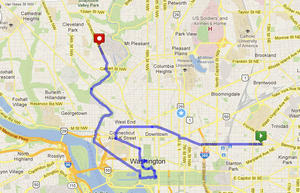
 With Raymond wielding the whip, the boys raced around the city. First, they excitedly steered the horse down Pennsylvania Avenue, careening past some of their favorite spots. They then shot down to the Ellipse, and took the horse through the muddied National Mall. For almost three hours they ran the horse to the ground, but Raymond eventually tired of this and thought it would be great fun to travel up to the National Zoo. He steered the horse towards the Pike and they made their way to Rock Creek Park. Once there, they entered the Zoo at its main entrance and began to tear down the hill. It was raining, and the muddy roads were very slippery. All at once little Raymond was unable to guide the beleaguered horse, and the horse, buggy, and boys flew over a fifteen-foot embankment, and crashed in a giant heap.
With Raymond wielding the whip, the boys raced around the city. First, they excitedly steered the horse down Pennsylvania Avenue, careening past some of their favorite spots. They then shot down to the Ellipse, and took the horse through the muddied National Mall. For almost three hours they ran the horse to the ground, but Raymond eventually tired of this and thought it would be great fun to travel up to the National Zoo. He steered the horse towards the Pike and they made their way to Rock Creek Park. Once there, they entered the Zoo at its main entrance and began to tear down the hill. It was raining, and the muddy roads were very slippery. All at once little Raymond was unable to guide the beleaguered horse, and the horse, buggy, and boys flew over a fifteen-foot embankment, and crashed in a giant heap.

Now apprehended, the two criminals were also taken to the station, while an angry Mr. Tate identified what was left of his buggy. After questioning the boys, William, speechless with terror, received only a summons and lecture about his behavior. However, Raymond – the mastermind of this ill-fated escapade – was sent to the House of Detention where he told authorities that he had the time of his life, explaining:
If the horse had held out, Bill and I'd have had a great time...We wasn't thinking about anything but the animals in the cages at the Zoo. We was driving along pretty fast, down the hill by the main entrance. The horse was going some, too, let me tell you - say, whose horse was it anyhow? I forgot to ask...Was I scared. Say you can't scare me with horses. I like horses.

It turns out this was not the first offense for young Raymond. Prior to his jaunt around DC, Raymond was picked up by police on two separate occasions for running away. A 1910 census entry for a Raymond Welty showed that the then seventeen year old was a member of the National Training School for Boys, a juvenile correction institution. Could this be the same Raymond? His rap sheet would suggest it as a strong likelihood.
Related Collections
- Record Unit 74 - National Zoological Park, Records, 1887-1966, Smithsonian Institution Archives
Produced by the Smithsonian Institution Archives. For copyright questions, please see the Terms of Use.

Leave a Comment